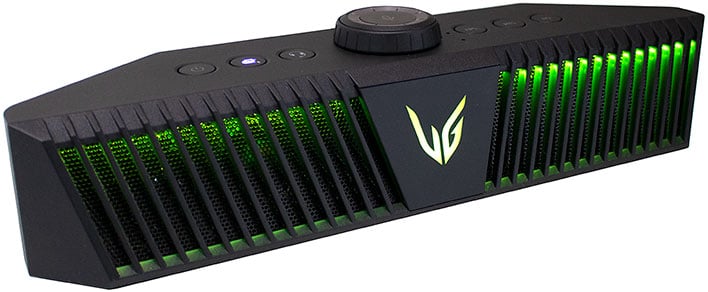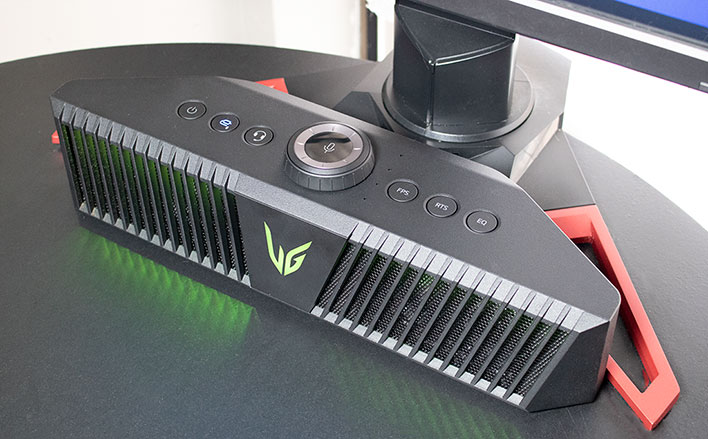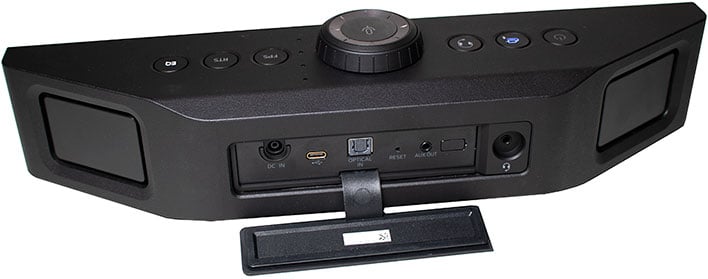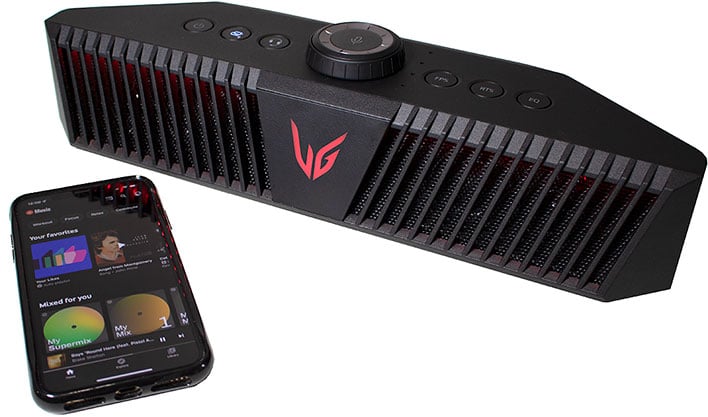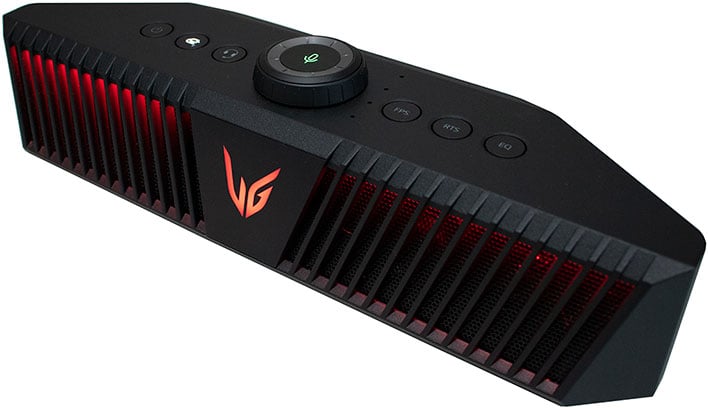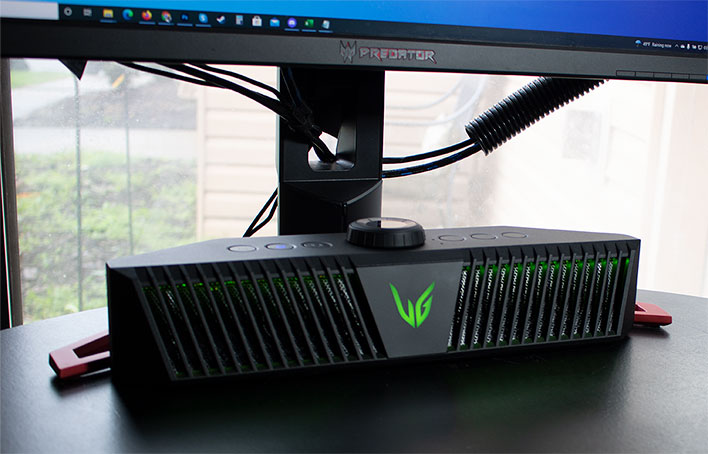LG UltraGear GP9 Review: Bluetooth Gaming Soundbar With Grunt, Lacks Grace
LG UltraGear GP9 Gaming Speaker: A Quick And Easy Soundbar Setup For Gamers
This past Summer, LG created a new product category with its UltraGear Gaming Speaker (GP9), though not entirely from scratch. The GP9 combines aspects of a soundbar with a portable Bluetooth speaker, and also serves as an external USB soundcard with a built-in Hi-Fi Quad DAC (ESS9038 Pro) to bring your headphones to life. It works with PCs, game consoles, and anything that blasts out audio through a Bluetooth connection. It also has a distinctive gamer aesthetic, or at least what LG thinks qualifies as one with the usual RGB lighting flare. But is it any good at everything or anything it's designed to do?
That's what I was eager to explore when LG unveiled this device, after having recently revamped my home theater from top to bottom, in part with a soundbar (replacing my dedicated surround sound receiver and discrete speaker setup). The simplicity of a soundbar appeals to me, and I imagine to many of you reading this as well. And if LG can bring a high-quality audio experience to the PC in a similar kind of form factor as it does for TVs, it may have an intriguing product on its hands that could serve PC and console gamers with a clean and easily configured solution.
LG UltraGear GP9 Gaming Speaker Specifications
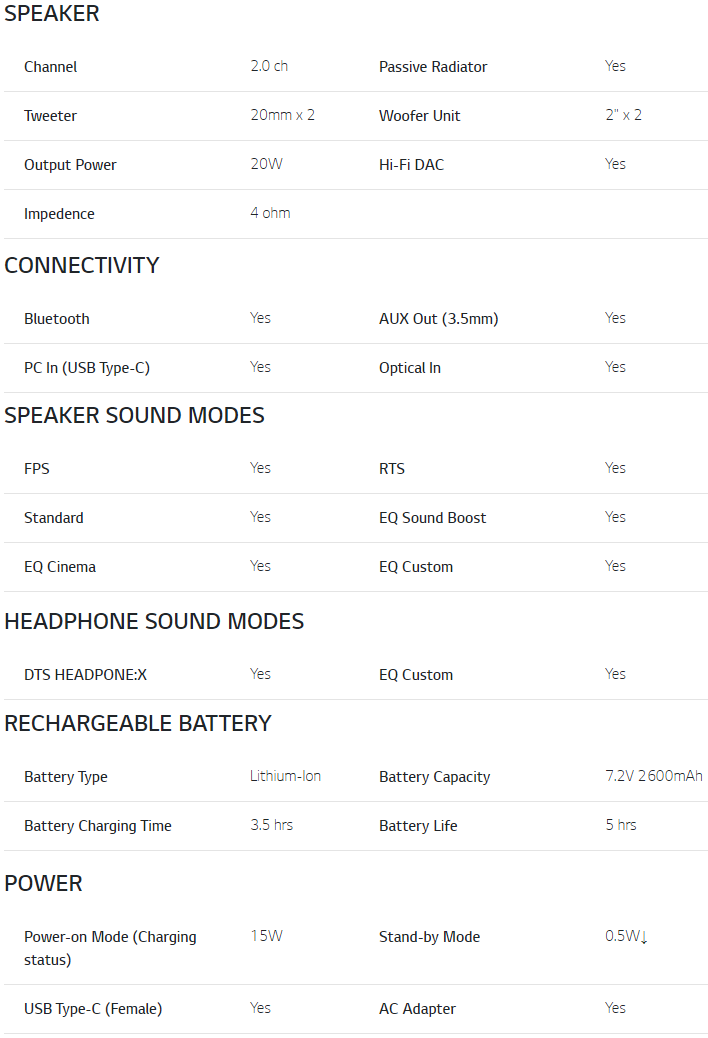
This is a 2.0-channel speaker with a pair of 20mm tweeters, one on each side, both flanked by a 2-inch woofer. LG rates the system's power output at 20W. That's fairly modest. As is common in smaller speakers, LG employs a passive radiator to coax more low-end belch from the speaker—a passive radiator derives its power from air pressure rather than electricity, for potentially bolder sound, without cutting into battery life.
The speaker is fairly compact, measuring 14.8 (W) x 3.3 (H) x 4.2 (D) inches. It weighs 3.3 pounds, which doesn't sound like much, but it packs some surprising heft for its size. That's to say, it's heavier than it looks, which is a good thing—it doesn't feel cheap or chintzy and its driver magnets are clearly on the heavier side. You could definitely knock a burglar out cold with this speaker, with a solid whack over the head (and the GP9 would probably survive the ordeal).
How fortunate too, because the GP9 certainly carries a hefty price tag. LG set the MSRP at $499.99, and the speaker is hovering around that price point a couple months after it was announced. It's a few bucks cheaper at Amazon, but this is essentially a five-hundred dollar speaker.
LG UltraGear GP9 Gaming Speaker Design And Features
LG bills this as the "first-ever sound solution designed specifically for gamers for gaming," which simply isn't true even by the loosest of translations. There are entire product categories that fit that description, including sound cards, gaming headsets, and discrete speaker setups. But a soundbar-slash-portable speaker for gamers? Now that is a first, as far as we're aware.
This is also the only speaker molded to slide in between the legs of certain gaming monitors with V-shaped feet, and specifically ones from LG's UltraGear line. I use a popular Acer Predator monitor on my main desktop, and the GP9 nestled in nicely for a mostly seamless fit, as you can see above.
The purposeful shape of the speaker also contributes to its menacing profile. There's a grizzly vibe with angled grill cutouts on the front, the amber glow of the RGB lighting (customizable), and LG's stylized and lit-up logo. Whether it hits or misses the mark is subjective. To me, it hearkens back to a less mature era in PC gaming when over-the-top designs were the norm. We don't think it looks bad per se, we're just not head-over-heels in love with it. Regardless, the formed shape for fitting underneath a gaming monitor is a welcome one that can potentially save some space on your desk surface.
Large buttons on the top offer convenient access to the core features. There's a power button on the far left, and next to that is a source button that cycles through USB, optical, and Bluetooth, with different colored lighting to indicate the current option (white for USB, red for optical, and blue for Bluetooth). And next to that is a button to turn your headset on and off, if you have one plugged into the auxiliary port on the rear.
On the other half of the speaker sit three more buttons, each related to sound profiles. The FPS turns on FPS Mode to purportedly make details more noticeable in first person shooters, while the RTS button engages RTS Mode for a wider audio landscape with "genuine spatial sound." In practice, I preferred not using either one.
The EQ button is perhaps the most useful one. Using an app on your smartphone, you can adjust the EQ settings or choose from a couple of pre-set profiles. It's worth it to spend some time dialing in the EQ settings to whatever pleases your ears, whether that be more or less bass, a higher or lower emphasis on treble, and so forth.
Then there's the unmissable volume dial in the middle. It's big and turns in steps, like a scroll wheel on a mouse. There's no indication of the precise volume level on the speaker itself, in case you turn the dial when no sound is playing. However, the LED lighting will flash a few times whenever you reach either end of the spectrum—volume turned all the way up or down. So when in doubt, just crank the wheel in either direction until the lights start blinking, then take it from there.
The speaker also boasts a built-in microphone array, which you an engage by pressing on the glossy top of of the volume wheel. When the mic is hot, the icon glows bright green.
Around back, there are a few input options, tucked behind a rubber flap. From left to right they include the DC-in jack, a USB-C port for connecting to your PC (via USB-A), optical input for game consoles, a reset hole, a 3.5mm auxiliary out jack, and another 3.5mm port for headsets.
LG includes a power brick and USB Type-C (speaker) to USB Type-A (PC) cable. If you intend to use this with a console via optical, you'll need to procure your own optical cable—a disappointing omission considering the price tag. Otherwise, you can use the USB cable, though you'll need the app so you can turn off the UAC 2.0 option.
Not visible is the built-in battery pack. The 7.2V 2,600 mAh lithium-ion battery is rated to deliver five hours of battery life, and takes 3.5 hours to charge. Unfortunately, this is not designed to be user-replaceable.
UltraGear GP9 Gaming Speaker Software And Experience Impressions
While completely optional, you'll get the most out of LG's gaming speaker with the LG XBoom app. It's a free app available on Android and iOS, and also easy to set up and use. Well, mostly...
The app connects to the speaker via Bluetooth, and that's easy enough to accomplish. Just hit the source button on the speaker until it toggles over to Bluetooth, then connect to it from your phone (or tablet) like you would any other Bluetooth device. Easy-cheesy. The issue I ran into is that it this procedure would need to be repeated most times I'd use the speaker with my PC. I'd turn the speaker on, fire up the app, and...nothing. It would tell me to go through the Bluetooth dance again, rather than just bringing up the dashboard.
When it is linked, the controls are pretty straightforward and a cinch to navigate. LG did a good job on the design, as it doesn't feel cumbersome, and there was a never a point where I felt like I couldn't quickly find the dial or knob I was looking for.
The volume slider is front and center in the app. There's also a battery life icon, virtual buttons to engage the microphone and/or microphone, and Sound Effect selections (Standard, FPS, RTS, EQ with Sound Boost). There are more options when your scroll down, and if you dig deeper into settings, you can find toggles for auto power management and other bits.
One of the most useful sections is the EQ page. This is where you can fine-tune the sound profile to your liking, based on your preference or the type of music you're listening to. If you're not familiar with EQ controls and just want to adjust the bass and treble more broadly, there are sliders for those, and altering them also changes the corresponding EQ value. That's pretty neat.
The only thing that's a bummer here is that the EQ controls are separated into two pages, so you have hit the left or right arrow to bring up the next set. You can actually view the entire waveform by clicking on the wave icon in the upper-right corner, but you can't actually make adjustments when it's in full view. Perhaps this will be added in a future software update.
You might also find yourself spending some time in the lighting section. You can adjust the RGB lighting on the speaker, though only through the app. That's also the only place you can turn it off altogether. Once nice thing about the lighting interface is that it changes in real time as you slide your finger across the color wheel.
LG UltraGear GP9 Gaming Speaker Sound Quality
How the speaker sounds is obviously the most important consideration, and quite frankly, it's a mixed bag. What muddies the water is the audacious asking price. In it's own right, the UltraGear Gaming Speaker delivers a surprising amount of oomph, considering its relatively small footprint.
However, here's what I was not expecting to see...
Those woofers like to boogie! Not that you'll see them, but you will feel them, to some extent. I have a small wooden desk, and the vibrations reverberated through, to where I could feel the bumps and thumps in my hand as I held my mouse. Same with my feet as they sat planted on a bottom wooden section of the desk. I actually enjoyed the sensation and didn't find it distracting.
It's a light sensation for sure, but noticeable. That said, there's not enough of a kick here to rattle the windows or shake the walls—this doesn't come anywhere close to what you'd get from a dedicated subwoofer. However, it's certainly not a tinny or thin-sounding speaker.
I listened to a variety of music on the UltraGear GP9, and that's where the results are the most mixed. For comparison, my main setup consists of a pair of Klipsch R-15PM powered monitor speakers, each on a stand. It's a different category of speaker, but also half the price, so I don't feel it's an unfair to pit the two against one another.
Next to those, LG's soundbar isn't as rich from top to bottom. Part of it comes down to preference, but as I switched between the two while listening to Say Something by A Great Big World (feat. Christina Aguilera), there was a hollowness to LG's speaker, compared to Klipsch's monitors.
This was pretty consistent across a variety of songs and genres. To LG's credit, the UltraGear Gaming Speaker hits harder on occasion too. I noticed this in Black Betty by Ram Jam. It still doesn't sound as good as Klipsch's speaker, as it is simply not as full-bodied. That's true across the entire spectrum (lows, mids, highs). However, the UltraGear GP9 is serviceable, and gets decently loud without distortion.
The issue here is that for $499.99, the audio quality should be better than serviceable. It should be excellent, or close to it. You can coax a richer sound profile out of this speaker by spending some time with the EQ, but you can only take it so far.
But What About Gaming Audio And Mic Performance?
It does much better in gaming, which is really the target application of course. That's because games typically provide a different listening experience, one that isn't as critical to music reproduction. Those spirited woofers do a good job with explosions and in-game grunts. I also was also surprised at how well it handled directional audio, at least from the front, left, and right sides. Even though I was used to sitting in between a pair of speakers, sounds coming from one side or the other on the UltraGear Gaming Speaker were surprisingly distinct.
LG also talks about a proprietary 3D gaming sound technology that purportedly incorporates a specially-designed HRTF (head-related transfer function) algorithm to produce "detailed virtual surround sound." This was less effective in my testing, and it's probably asking too much of a front-placed speaker setup to engulf the listener in 360 degrees of audio. That said, sounds from behind do actually sound a little bit different, mostly because they're quieter. This is not quite actual surround sound, but it's something at least.
I was less enthralled with the FPS and RTS presets. These alter the sound profile to highlight certain aspects, but I prefer the full sound experience and therefore found myself not utilizing them.
More interesting, and impressive, are the built-in microphones. LG says the microphones leverage a "unique echo-cancellation algorithm" that can distinguish a user's voice from game sounds and background noises. It sounds like marketing hype, but to my absolute surprise, it works splendidly. Whether playing music and cranking up the volume, or shooting at enemies lobbing grenades, somehow or another none of the noise transmits to the person on the other end.
I used Skype's test calling feature to hear (or not hear) this for myself. LG calls it an algorithm, I say it's some kind of voodoo magic. Regardless, it woks as advertised.
Final Thoughts On LG's UltraGear GP9 Gaming Speaker
On its own, I'm intrigued by LG's compact gaming soundbar. It's relatively easy to operate, it snuggles neatly in between the outstretched legs of a typical gaming monitor, and works with a variety of devices. It's even a portable speaker, which is a neat perk.
I'm also okay with the aggressive design. I don't find it particularly offensive, nor am I infatuated with its looks, though I do appreciate the ability to customize the RGB lighting (or turn it off). I just wish this could be done on the speaker itself, without having to fire up the app.
Of course, it's the sound quality that matters most, and that's where this speaker struggles to justify its asking price. At $499.99, this is not an inexpensive speaker. There's some added value in its portability, compact footprint, and versatility, but not to the point where the MSRP feels justified. Not that it sounds bad, but we definitely expect a fuller audio experience in this price range.
The potential saving grace is that it does well with gaming, which is what the LG UltraGear GP9 is built for. You're usually not firing up a game for a concert-like audio experience, so this speaker can get away with a somewhat hollower profile. It also does a surprisingly good job with left and right positional sounds, and has a bit of punch. On top of that, the built-in mics somehow prevent your teammates from hearing anything other than your voice.
We not sure if you'll be able to find this speaker at a local Best Buy or Walmart, where you can demo it before committing. However, much as we wanted to fall in love with this speaker, we just didn't, not for five Benjamins. That said, it's offered online at a variety of retailers, including Amazon, which is usually great about handling returns. The LG UltraGear GP9 is definitely worth giving a trial run, if you're interested in this form factor and list of features, just temper your expectations.

 |
 |
||
|
|


